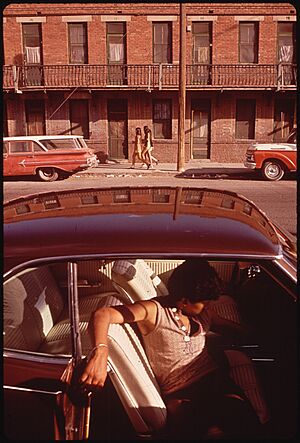Barrioization facts for kids
Barrioization is a idea developed by Chicano experts Albert Camarillo and Richard Griswold del Castillo. It helps explain how neighborhoods for Chicano and Latino people in the United States were formed and kept separate. These neighborhoods are often called barrios.
The word was first used by Camarillo in his 1979 book, Chicanos in a Changing Society. Griswold del Castillo explained this process for Los Angeles in his 1979 book, The Los Angeles Barrio, 1850-1890: A Social History. Camarillo said barrioization means "the creation of separate Chicano barrios or neighborhoods where people live." This idea is used in the study of Human Geography.
What Does "Barrioization" Mean?
The word barrioization comes from the Spanish word barrio. Barrio means neighborhood or a part of a city.
This term was first used in the New World (the Americas) to describe Aztec calpullis. These were like neighborhoods in the Aztec capital city, Tenochtitlan. Tenochtitlan had about 60 calpullis. When Spanish explorers arrived in 1519, they called these calpullis barrios. At that time, barrio had a similar meaning in Spain.
The first barrios in the Americas were mostly home to Indigenous peoples, especially in what is now Mexico. Over time, barrio started to mean areas in cities in Mexico where working-class people lived. This was because Indigenous peoples often had working roles in the colonial system.
How Did Barrioization Happen in Los Angeles?
The city of Pueblo de Los Angeles was started in 1781. Expert Richard Griswold del Castillo says there's no proof the word barrio was used in California before 1848. However, the nearby village of Yaanga "may have been seen as a barrio." The pueblo was built using workers from the local Indigenous village. It depended completely on their work to survive.
After Anglo-Americans took over Los Angeles, the word barrio got a new meaning. By 1872, Spanish-speaking newspaper editors were writing about problems in the barrio. Anglo-Americans called this area Sonoratown. People in this community worked hard for low pay. It was a place with many challenges, like poverty. But it was also a place where Spanish-speaking residents could "feel at home." They could relax and be themselves, away from the Anglo-American world.
In 1860, Mexican Americans made up about 75% of Los Angeles's population. The city was divided into rich and poor areas. Most new Mexican immigrants lived in poorer parts, with Sonoratown being the largest. Wealthy Californios (Mexican Americans who had lived in California for a long time) lived in richer areas. They moved away from the central plaza as Sonoratown grew.
Mexican Americans were separated because they had limited chances to own property in wealthier areas. This meant their property was mostly in poorer parts of the city. A small number of Mexican Americans became more successful. However, they often tried to blend in with Anglo-Americans. This made the Mexican American community less strong politically. Not all Mexican Americans wanted to blend in during the 1800s. Many openly welcomed white people into their groups. But changes in the population of Los Angeles greatly reduced Mexican American political influence by the late 1800s.
Today, the southeastern part of Los Angeles County has "one of the largest and highest concentrations of Latinos in Southern California." This is according to geographer James R. Curtis. He is often credited with using the term in AP Human Geography.


